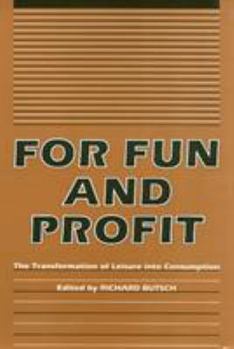For Fun and Profit: The Transformation of Leisure Into Consumption
(Part of the Critical Perspectives on the Past Series)
Select Format
Select Condition 
Book Overview
During the nineteenth century, leisure industries emerged to provide recreation and entertainment to Americans of all classes. By the 1920s, commercialized leisure was big business. This work contains... This description may be from another edition of this product.
Format:Paperback
Language:English
ISBN:0877227403
ISBN13:9780877227403
Release Date:June 1990
Publisher:Temple University Press
Length:288 Pages
Weight:0.80 lbs.
Dimensions:0.6" x 6.0" x 9.0"
Customer Reviews
1 rating
Excellent colection of essays on leisure.
Published by Thriftbooks.com User , 22 years ago
For Fun and Profit: The Transformation of Leisure into Consumption is a marvelous collection of essays, which, interestingly contains one by aforementioned Kathy Peiss entitled Commercial Leisure and the "Woman Question. Richard Butsch's leisure and Hegemony in America traces the gradual process of leisure into consumption when he recalls the days in America, two hundred years ago, when children's toys and games were self-made. It was not until the late nineteenth century that leisure pursuits became purchased products. The Theater Syndicate United Booking Office bought the rights to theater and vaudeville. In John Clarke's essay, Pessimism versus Populism: The Problematic Politics of Popular Culture, the author writes that the two scholarship schools on popular culture are defined by pessimism (the rise of centralized production and "mass culture") and populism ("working-class culture" or "popular culture." (Butsch; Clarke, 28-47). Thus still there is disagreement between what constitutes actual leisure. Butsch echoes the lack of a cohesive theoretical framework found in Women's Leisure, What Leisure?, but in his collection of essays attempts to determine what leisure is. He divides leisure historically in America in three periods, the first ending at 1830 and the second in 1880. Prior to the 1830s, the workplace was also the place of leisure, and by the 1850s, the New York working class established their own centers of entertainment apart from the leisure class. After 1880, it is easy to see how leisure became marketed.Fascinating studies on how corporations sought out marketing strategies, usually at the instigation of state policies, comprise the bulk of the essays in the book. But Ellen Wartella and Sharon Mazzarella's essay, A Historical Comparison of Children's Use of Leisure Time argues effectively on how the Progressive era provided the groundwork for children's previously ignored need for leisure. This recognition led to a number of establishments, including the Child Welfare Stations, White House Conferences on children, the 1912 Children's Bureau, etc. The implementation of these government and voluntary services were not completely altruistic, since it became painfully aware to reformers in urban areas that the children were quite literally the future of the nation.




